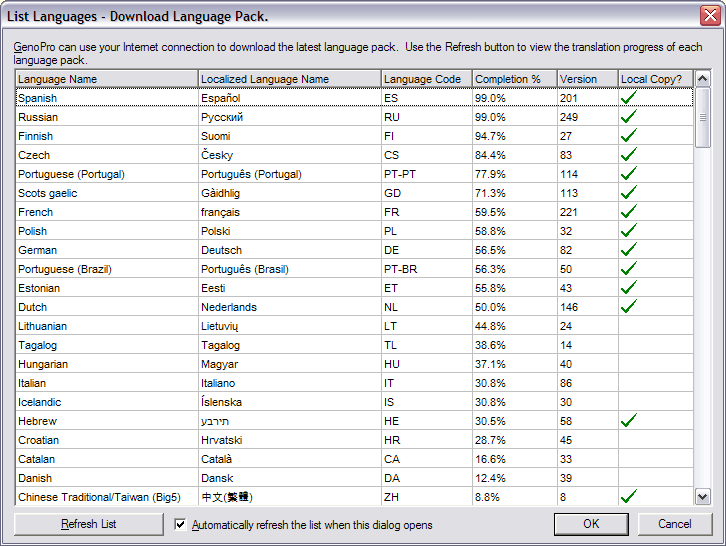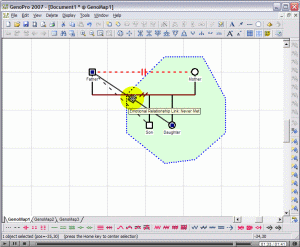|
Dear Firstname,
Welcome to the sixth edition of the GenoPro Newsletter. If you missed our
previous newsletters they are available online.
We just released GenoPro version 2.0.0.6. This version includes several changes, including the ability to translate (localize) GenoPro in any of the 140 language available. To download GenoPro 2.0.0.6, use the following link: https://genopro.com/InstallGenoPro.exe

GenoPro v2.0.0.6 has a build-in collaboration module for its localization. You can have access to this new feature from the Language menu item of the Tools menu. This collaboration system allows everyone to contribute to the translation of GenoPro. At the moment, GenoPro offers a graphical interface to localize the menus, dialogs, enumeration and tags. We will offer more localization options in the next update.
For more information, visit https://www.genopro.com/translation/
We plan to bundle the most popular languages within GenoPro, and make other languages available via download. We created a poll to determine the most popular language among our users. Cast your vote!
By popular demand, we have created a tool for users to modify their HTML report online. This tool is useful if you need to add additional files to your report, such as pictures, video clips, rename existing files or delete unwanted files. This tool is similar as a regular FTP Client, however was designed for online reports published at http://FamilyTrees.GenoPro.com.
Download our "FTP Client" tool at https://www.genopro.com/help/ftp-client/ (104 KB)
By Laura M. Benton, from the Multicultural Family Institute.
According to family therapist Murray Bowen, the two-person relationship is the basic unit of any emotional system. However, the two-person system is an unstable system in the sense that, under stress, it tends to draw in a third to stabilize, creating a three-person system of two-against-one, or two-helping-one. When the anxiety gets high enough in any one triangle, it spills over into other triangles, spreading further and further into the whole family system.” Thus, triangles form when discomfort in a two-person relationship runs high and expands into other relationships in the family, binding family members into a series of repetitive interactions and roles. These interactions can develop into problematic behavior patterns in the unwitting participants of the triangle.
When there is discord between two people, they commonly attempt to alleviate the discomfort by forming a triangle with a third. Families repeat themselves. According to Monica McGoldrick in the upcoming third edition of her book on Genograms (W.W. Norton, 2007), “What happens in one generation will often repeat itself in the next; that is, the same issues tend to be played out from generation to generation, though the actual behavior may take a variety of forms….[and] relationship patterns in previous generations may provide implicit models for family functioning in the next generation. On the genogram, we explore patterns of functioning, relationship, and structure that continue or alternate from one generation to the next.”
Using a genogram enables us to gain insight into intense familial relationships, and “given the family’s structure and position in the life cycle, to hypothesize about the important relationships and boundary patterns of that family. Understanding triangular patterns where two family members join against a third is essential in understanding family relationships. ‘Detriangling’ is an important process through which family members free themselves from rigid triangular patterns.” (Genograms 3rd ed, Ch.1) The presence of relationship triangles can be seen in the Bush family, where family members appear to be unwittingly following the patterns of triangling of previous generations as they form their own families.
George Herbert Walker Bush and his wife Barbara had three young children (George W., age 6, Robin, age 3, and Jeb, a newborn) at the time that their middle child, Pauline Robinson Bush whom the family called Robin, was diagnosed with leukemia. Robin was named for Barbara’s mother who had been killed in a car accident (in which her husband was driving), just three months before Robin was born. The parents never told George that she was ill, though they did instruct him to stop playing with her, his major playmate, because she was becoming more frail. During Robin’s illness, both parents spent a lot of time away from their home in Midland, Texas, taking her to Memorial Sloan Kettering hospital in New York, where George’s uncle, was a doctor. Robin was given treatments there and her parents stayed in the uncle’s apartment. Tragically, despite the intense treatment, Robin died two months before her fourth birthday. During her illness, George W. and Jeb, as often happens with siblings when parents must take care of one child who is very ill, were left home to be cared for by neighbors and extended family (Kelley, 131).
Read complete article - Triangles in the Bush Family
 |
Video: Single Parent Raising the ChildrenIn this video, the user should learn:
|
 |
Video: Adoption and Foster ChildIn this video, the user should learn:
|
This newsletter was sent to email@example.com. You are receiving this newsletter due to one of the following reasons:
Use the GenoPro Control Panel to update your contact information, such as name or add alternative email address.
Visit https://www.genopro.com/unsubscribe/ to remove your email from our newsletter. We honor every "Unsubscribe" claim, no questions asked.